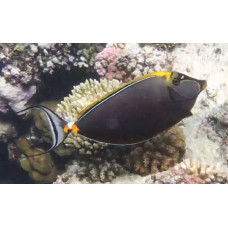Latin name
Naso lituratus
Other name
Orangespined unicornfish, black-finned unicornfish, Pacific orangespined unicornfish, blackfinned unicornfish, stripefaced unicornfis.
Identification
Characteristic features of Naso lituratus include orange lips, a caudal peduncle with a curved spine, and a black mask on the snout. The caudal peduncle bears two sharp lobes pointing forward. The forehead lacks the "horns" or anterior projection seen in some other species of Acanthuridae. The body depth of adults is 2.6-3.0 inches across; the dorsal profile of the head is oblique and slightly convex (forehead absent). Two large foot plates, keels with anteriorly projecting ends in adults.
Features of fish fins
Spiny dorsal fin rays (total): 6; articulated (soft) dorsal fin rays (total): 26-29; spiny anal fin rays 2; articulate (soft) anal fin rays: 27 - 30. The caudal fin is elongated in juveniles and truncated, crescent-shaped in adults.
Fish colouring
Body brown to bluish gray, ventral half yellowish gray to yellow, often with sharp and irregularly defined mid-flank border; gill and tarsal margin usually with dark brown band; lower lip margin usually white, upper surface of tongue black in adults; gill stamens blackish at base; Caudal fin blue with a broad brownish-yellow border behind, tapering to the corners of the fin; may be pale gray-blue overall; during courtship, males rapidly develop a broad bluish-white stripe on the back of the head and front of the body, followed by narrow stripes of the same color extending to the underside.
Distribution
They inhabit the eastern Indian and Pacific Oceans.
Habitat
Tropical marine benthopelagic species. Depth limits are 0 - 90 m, usually 5 - 30 m. Habitat is coral reefs around the oceans.
Size
Maximum length: 46 cm; maximum weight: 2.3 kg.
Behavior
Adults usually live in small groups. Juveniles live on shallow rocky reefs, sometimes in small schools mixed with other Acanthurid of similar size. The self-defense tactic of this species is to extend their strong tail spines to strike at any approaching predator.
Food and feeding habits
Feeds mainly on brown leaf algae (Sargassum and Dictyota).
Reproduction
The breeding peculiarity of this species is that Acanthuridae have two sexes and distinct size differences. Spawning in Guam occurs throughout the year. They require high oxygen levels and strong currents.
Fishing
Not commercially important in fisheries.
Relationship with a person
Naso lituratus is widely used by humans as a food source and as an aquarium commodity. It is classified as a poisonous species.
| Classification | |
| Phylum | Chordata |
| Class | Actinopterygii |
| Squad | Acanthuriformes |
| Family | Acanthuridae |
| Genus | Naso |
| Species | N. lituratus |
| Features | |
| Conservation status | Least Concern |
| Habitat | Pelagic |
| Life span, years | No information |
| Maximum body weight, kg | 2,3 |
| Maximum length, cm | 46 |
| Sailing speed, m/s | No information |
| Threat to people | Edible |
| Way of eating | Bentophage |
Clown unicornfish
Tags: clown unicornfish


